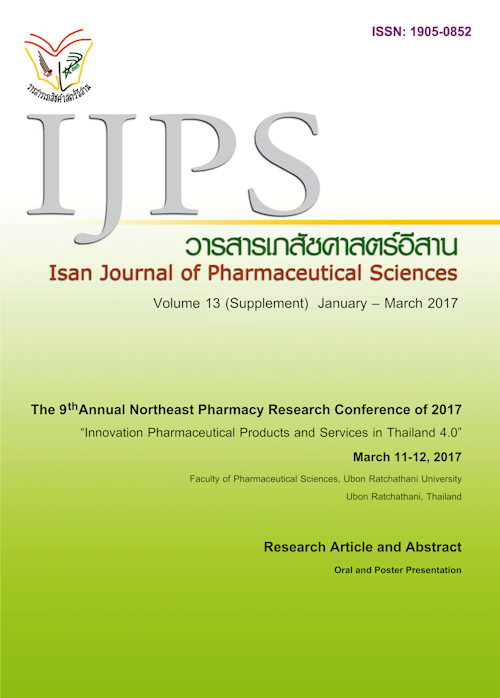The Relationship between EPS and Risperidone in Autism Spectrum Disorders by Prescription Sequence Symmetry Analysis
Main Article Content
Abstract
Introduction: At present, the incidence of Autism Spectrum Disorders (ASDs) steadily increases. Antipsychotic drug recommended for treatment of ASDs and available in Thailand is Risperidone. However, it can cause Extrapyramidal side effects (EPS). The objective of this study was to measure the relationship between EPS and risperidone in ASDs by a screening tool called Prescription Sequence Symmetry Analysis (PSSA). Methods: This retrospective research used data from electronic database to identify prescriptions initiated with anticholinergic drugs before initiation of risperidone (Marker to Index) and prescriptions initiated with risperidone before initiation of anticholinergic drugs (Index to Marker) during January 1, 2011 to December 31, 2015. PSSA was used to analyze the relationship between risperidone and EPS and presented as sequence ratio. Results: Of 23 prescriptions identified, 20 (86.96%) prescriptions initiated with risperidone before the initiation of anticholinergic drugs (Index to Marker) and 3 (13.04%) prescriptions initiated with anticholinergic drugs before initiation of risperidone (Marker to Index). The sequence ratio (SR) was 6.67. Conclusion: Risperidone was associated with EPS in ASDs patients from PSSA which is convenient tool to use for drug safety surveillance.
Article Details
In the case that some parts are used by others The author must Confirm that obtaining permission to use some of the original authors. And must attach evidence That the permission has been included
References
Abouzaid S, Tian H, Zhou H, Kahler KH, Harris M, Kim E. Economic burden associated with extrapyramidal symptoms in a medicaid population with schizophrenia. Community Ment Health J. 2014; 50 (1): 51-8.
CDC. Prevalence of autism spectrum disorder among children aged 8 years - autism and developmental disabilities monitoring network, 11 sites, United States, 2010. Morbidity and mortality weekly report Surveillance summaries. 2014; 63 (2): 1-21.
Hallas J. Evidence of depression provoked by cardiovascular medication: a prescription sequence symmetry analysis. Epidemiology. 1996; 7 (5): 478-84.
Kongsakon R, Leelahanaj T, Price N, Birinyi-Strachan L, Davey P. Cost analysis of the treatment of schizophrenia in Thailand: a simulation model comparing olanzapine, risperidone, quetiapine, ziprasidone and haloperidol. J Med Assoc Thai. 2005; 88 (9): 1267-77.
Lai EC, Hsieh CY, Kao Yang YH, Lin SJ. Detecting potential adverse reactions of sulpiride in schizophrenic patients by prescription sequence symmetry analysis. PloS one. 2014; 9 (2): e89795.
Leucht S, Corves C, Arbter D, Engel RR, Li C, Davis JM. Second-generation versus first-generation antipsychotic drugs for schizophrenia: a meta-analysis. Lancet. 2009; 373 (9657): 31-41.
National Institute of Health. National Database for Autism Research 2016 [December 1, 2016]. Available from: https://ndar.nih.gov/about.html.
Sinrachatanan A. Guidelines for Treatment of Interlectual Disabilities, Autism, Attention Deficit Hyperactive Disorders, and Learning Disorders for Healthcare Service System. Department of Mental Health, Ministry of Public Health: Fast-book; 2003.
Wahab IA, Pratt NL, Wiese MD, Kalisch LM, Roughead EE. The validity of sequence symmetry analysis (SSA) for adverse drug reaction signal detection. Pharmacoepidemiol Drug Saf. 2013; 22 (5): 496-502.


